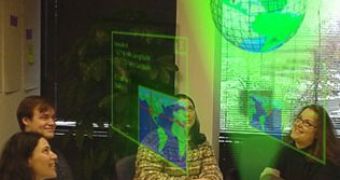The word hologram comes from Greek, with holos meaning whole and graphe meaning writing.
A hologram is an advanced form of photography that allows an image to be recorded in three dimensions, in fact a recording of an interference pattern made by the interaction of two beams of light.
If two stones are dropped into water, waves radiate from the points of impact. Where the two sets of waves meet, the waves appear to pass through each other; however, where a crest of one wave coincides with a crest of the other wave, an extra high crest will form. Similarly, two troughs coinciding will form an extra low trough. A crest and a trough meeting will cancel each other out. Since light travels in waves, two light beams crossing will have similar crests, troughs and level patches, forming light and dark fringes. If a suitable photographic film is inserted where the beams coincide, it can record this fringe pattern.
You've just found a key to understanding how a hologram works. But what do waves in a pond have to do with those amazing three-dimensional pictures? How do waves make a hologram look like the real thing? Much like the ripples in a pond, light travels in waves. When you look at, say, an apple, what you really see are the waves of light reflected from it. Your two eyes each see a slightly different view of the apple. These different views tell you about the apple's depth -its form and where it sits in relation to other objects. Your brain processes this information so that you see the apple, and the rest of the world, in 3-D.
A hologram can capture a 3-D image so lifelike that you can look around the image of the apple to an orange in the background - and it's all thanks to the special kind of light waves produced by a laser.
White light from the sun or a light bulb is a combination of every color of light in the spectrum, a mix of different waves that's useless for holograms. But a laser shines light in a thin, intense beam that's just one color. That means laser light waves are uniform and in step. When two laser beams intersect, like two sets of ripples meeting in a pond, they produce a single new wave pattern: the hologram.
Here's how it happens: light coming from a laser is split into two beams, called the object beam and the reference beam. Spread by lenses and bounced off a mirror, the object beam hits the apple. Light waves reflect from the apple towards a photographic film. The reference beam heads straight to the film without hitting the apple. The two sets of waves meet and create a new wave pattern that hits the film and exposes it. On the film all you can see is a mass of dark and light swirls, it doesn't look like an apple at all! But shine the laser reference beam through the film once more and the pattern of swirls bends the light to re- create the original reflection waves from the apple, exactly.
Not all holograms in the world work this way, some use plastics instead of photographic film, others are visible in normal light. But all holograms are created with lasers and new waves.
The first step to making your own hologram is setting up an optical table. This is simply a device to neutralize as many vibrations as possible. When making a hologram even the smallest vibrations (100ths of a millimeter) can cause your image to get ruined. An optical table us usually a very sturdy table that is filled with lots and lots of sand so that vibrations can't reach the mirrors, lenses, etc. easily. This also allows you to position things exactly where you want them on a sturdy base.
To test your table, you usually use our good old friend: the Michelson Interferometer . The idea behind this device is that your laser beam is split into two beams, recombined, then projected onto a surface. This produces a interference pattern. If the pattern is stable, your table is good. If the patter in changing you know that something is causing movement, like air currents, vibrations or just something toughing the table.
If you can get all the required materials, and you have some advanced understanding of physics, you could, in theory, make yourself a working hologram.

 14 DAY TRIAL //
14 DAY TRIAL //